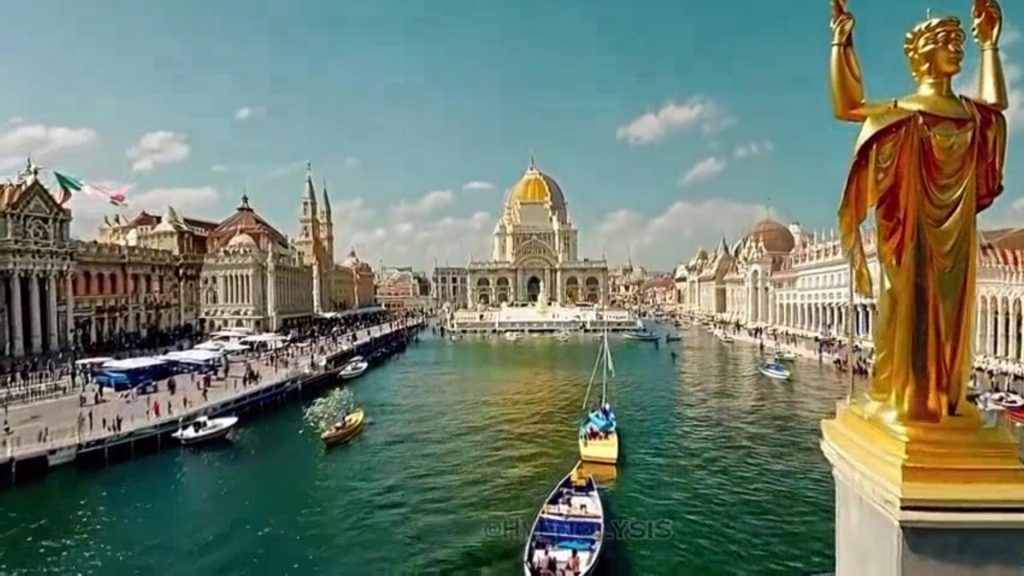Would you believe me if I told you that there was a city in America that looked like this? That’s the city of Chicago over 130 years ago and it looked like a whole other world. Often referred to as “the White City” for its gleaming Neo-classical buildings, this historical architecture stands as a testament to human achievement and vision. This was the chosen location for the 1893 World’s Columbian Exposition, also known as the World’s Fair. This looks absolutely nothing like Chicago does today.
The fairground sprawled over 600 acres, featuring more than 200 Monumental structures that defied people’s imagination at the time. More than 27 million people attended the exposition during its six-month run. Through preserved footage and photographs we witness the Splendor of this event. Attendees marveled at architectural wonders and engaging with groundbreaking technological displays.
The liberal arts and manufacturers building alone covered nearly 32 Acres, with the capacity to fit four of the great Roman Coliseums inside it and seat 300,000 people. Its vastness was almost incomprehensible.

One of the events most iconic images was the 65- Ft golden statue of the Republic, gleaming in the Sun and towering over the central Lagoon of an elaborate Canal system that was very similar to ancient Venice. Visitors could cover more territory by traveling in Venetian style gondolas through the canals that spanned through most of the fairgrounds.
The fair also showcased the wonders of electricity, with entire buildings illuminated by thousands of incandescent bulbs. This took place in the time when Nikola Tesla, the inventor of AC Electrical systems had won “the war of the currents” against Thomas Edison’s DC Electrical systems. The integration of electrical power into nearly every aspect of society can in many ways be traced back to this historical event.
Technological marvels such as the first practical electric automobile and the first electric kitchen with an automatic dishwasher were also introduced. Among the fair’s most novel and impressive exhibits was the first ever Ferris wheel. It stood 264 ft tall and could carry over 2,000 passengers at a time. This giant observation wheel gave many their first bird’s eye view of the city. Another groundbreaking exhibit was the introduction of the moving walkway, a precursor to the modern escalator.
As we delve deeper into the World’s Fair events, a pattern begins to emerge, one that seems to defy the conventional history we’ve all been taught. In cities all over the world we consistently see the same Grand and ornate structures, civil engineering and infrastructure projects being constructed on a colossal scale within an impossible time frame.
As we observe the fairgrounds, a question lingers, how were these monumental structures built in such a time span? the official narrative suggests the exposition was built in Just 2 years but the logistical challenges of the late 19th century cast doubt on this rapid timeline.
less than 30 years after the Civil War, we find cities like Chicago looking as if they could be part of Vatican City or anywhere else in Old World Europe, yet we’re told that everything was built using wood plaster and temporary materials with the intention of demolishing them when the fair ended.
Furthermore, the reported materials used plaster jute fiber and other temporary substances raise concerns about durability. With millions of visitors, the wear and tear on these hastily constructed buildings would have been significant.
Additionally, the construction of the canals, especially within the swampy terrain of Jackson Park added another layer of complexity. building these waterways required significant excavation water management and structural work all within the same tight timeline.
How did these structures and canals withstand the immense foot traffic, the elements and the test of time even if just for the duration of the fair? it’s a puzzle that challenges the official narrative and fuels speculation.
The architectural marvels of the fair labeled as temporary, have long been a source of intrigue. Their intricate designs and sheer Grandeur seem disproportionate for structures meant to only last for a short time. However, without exception, some isolated buildings still stand today because some were constructed with permanent materials, everything else got destroyed. But we get a glimpse of the craftsmanship involved through structures like the Art Institute of Chicago and the Museum of Science and Industry. In Chicago’s case, the majority of the fairgrounds didn’t need to be demolished because they were conveniently destroyed by fire a few months after the event ended.
Why were certain buildings constructed from permanent materials and why did they so often hold the title of the world’s largest buildings at the time? It raises the question; how could the world’s largest buildings have been constructed using mostly temporary materials?
Are we to believe that just over a century ago, people made a habit of building some of the largest most magnificent and ornate buildings ever seen only to use them for a few months? Even if we disregard the buildings themselves, the Earthworks involved in these projects would challenge modern capabilities and Equipment under such tight timelines and most importantly, why would they do all of this just to destroy it?
Could the World’s Fair events have been the perfect cover to hide the remnants of a unified global system that existed before the upheaval of the Civil War and two world wars were used to reshape our world? The similarities between the narrative surrounding the fairs, the architecture and the scale all seem to point to something more than coincidence. It suggests a carefully orchestrated Erasure of a past we were never meant to remember.
A great example would be the lost civilization of the Tartarian empire but I’ll save that for another video.
We have to ask ourselves, how much of our history has been Rewritten, what has been lost and how much has been hidden in plain sight?
